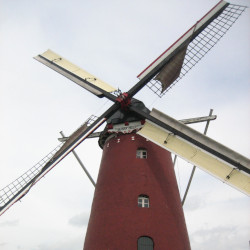THE WENNINKMOLEN IN LINTELO
A typical hamlet, Lintelo, nestled between the Slinge River to the north and the Keizersbeek to the south. Situated along tree-lined roads in an open landscape dotted almost casually with small clumps of forest. Now, like many hamlets, it has a core of modern housing developments; in the past, it consisted of scattered farms located on the higher sandy grounds, surrounded by vast stretches of heathland and wet meadows.
The residents don’t consider their hamlet anything special; they’re not ones to boast. Still, they do have something that stands out: industrial heritage in the form of the Wenninkmolen (Wennink Mill). Perched on its mound, it serves as a beacon in the landscape—a "landmark" as it’s fashionably called today—visible from afar, much like the church towers in larger hamlets and villages in the Achterhoek. What could be more typically Dutch?
Built in 1860, during a golden age for agriculture, with the great agricultural crisis of 1875–1885 still a distant shadow. Its construction back then was no coincidence: the first owner, Wennink, took the leap, encouraged by high grain prices and steadily rising grain production. Was it also done—this should be mentioned—because the residents of this hamlet paid by far the most land tax (verponding) of all the hamlets in Aalten?
The arrival of the mill must have been a source of pride. It was a sign that things were going well for the hamlet, a mark of increasing activity. It also provided social engagement. As farmers waited their turn with grain-laden wagons to enter the mill, there was plenty of chatting and catching up.
After several changes of ownership over the years, a completely new situation arose on December 27, 2007: Mr. H. Nijland, from the construction company bearing his name, transferred the mill—which had long held the status of a national monument—to a non-profit foundation.
A new chapter began. Volunteer board members, driven by enthusiasm, aim to restore the mill to its former glory as a vibrant and social center of the hamlet.
To name just a few goals: a venue for meetings, theatrical performances or concerts; a place where children can learn about technology through the ingenious milling machinery; where tourists can discover the phenomenon of the windmill and the region’s history. That is the board’s vision. All these activities are also essential for raising the necessary funds. Each year, maintenance alone costs €10,000, of which €2,000 falls under the responsibility of the new board. In addition, there is at least another €3,000 in insurance premiums. In total, at least €5,000 must be raised annually, with no guaranteed income.
You understand: EVERY CONTRIBUTION IS WELCOME
Further on, you’ll find a form to register as a donor or sponsor for the Foundation for the Preservation of the Wenninkmolen in Lintelo (the foundation has ANBI status, so donations are tax-deductible).
We are also very happy with people who want to join us in building a new future for this beautiful mound mill. Any help is appreciated: ideas, board membership, helping with events, organizing, or doing practical work on the mill. You can register with the board members or during public openings at the mill.
To sign up as a donor, you can fill out the SEPA authorization form and drop it off at the mill or place it in the mailbox at Gendringseweg 27 in Lintelo.

